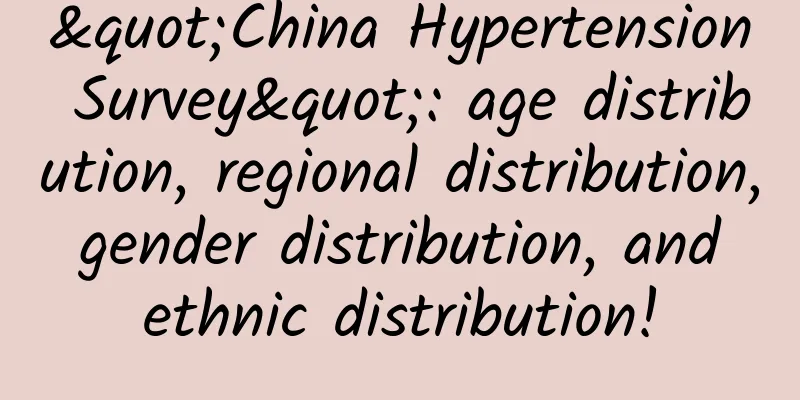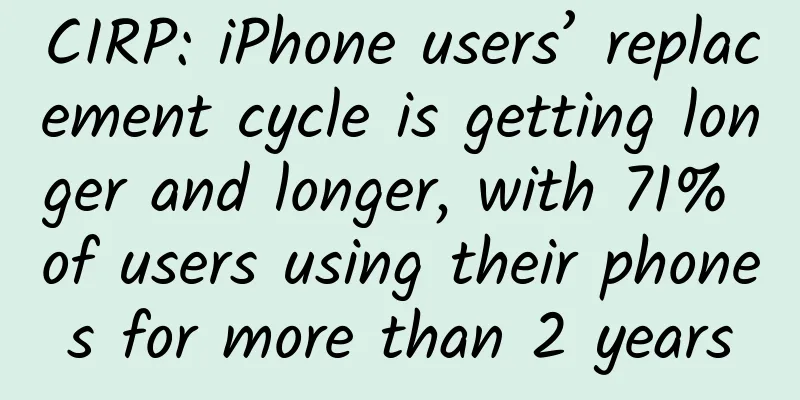"China Hypertension Survey": age distribution, regional distribution, gender distribution, and ethnic distribution!

|
Our country can be said to be a country with a high incidence of hypertension. One reason is that we have a large population base. Another reason is that it is related to the rapid changes in our lifestyle. A rough estimate is that almost one in four adults has high blood pressure. Let's take a look at the data from the "China Hypertension Blue Book" and the "China Hypertension Prevention Guidelines": First, age distribution: Survey data show that from 2012 to 2015, the crude prevalence of hypertension among Chinese residents aged 18 and above was 27.9% (standardized rate 23.2%); that is, for every 100 people over the age of 18 in my country, 23.2-27.9 people have hypertension. 18 to 24 years old, 4.0% 25 to 34 years old, 6.1% 35-44 years old, 15.0% Obviously, the incidence rate increases with age. In 2012, the prevalence of hypertension among people aged ≥60 years in my country was 60.6% in urban areas and 57.0% in rural areas; That is to say, after the age of 60, 6 out of 10 people have high blood pressure. As we age, the incidence of hypertension increases, which is closely related to our long-term lifestyle. That is, the longer we have unhealthy diet, unhealthy lifestyle, lack of exercise, obesity, smoking and drinking, the greater the damage to our blood vessels. As we age, hypertension will show symptoms. This results in the risk of hypertension in people aged 60 and above increasing by 8.53 times compared to those aged 18 to 44. Second, geographical distribution The prevalence of hypertension is highest in the eastern region of my country (32.6%), followed by the northeastern region (31.8%), and the lowest is in the southwestern region (20.1%). In terms of urban-rural distribution, the prevalence of hypertension among people aged 15 years and above in urban areas in Heilongjiang Province was higher than that in rural areas (31.3%>29.7%); The prevalence of hypertension among people aged 18 to 79 in Beijing is higher in urban areas than in rural areas (35.6%>34.9%), but the difference between urban and rural areas has been gradually narrowing in recent years. The top three: Beijing, Tianjin and Shanghai, show the characteristics of large and medium-sized cities with a high prevalence of hypertension. For example, the prevalence of hypertension among residents in Beijing, Tianjin and Shanghai are 35.9%, 34.5% and 29.1% respectively. In general, the north is higher than the south; cities are higher than rural areas; and developed cities are higher than other cities. The higher blood pressure in the north than in the south may be related to the larger natural environment, but it is mainly because northerners eat more salt and have a stronger taste. The higher blood pressure in cities or big cities is related to high stress, fast pace of life, and mental labor. Third, gender-based disease In 2012, the prevalence of hypertension among adults aged 15 to 74 in Henan Province was 24.9%, with a higher prevalence among men (26.6%) than women (23.5%). In 2010, the prevalence of hypertension among 17,437 residents aged 18 and above in southern my country was 22.59%, with a higher prevalence in males (23.36%) than in females (21.77%). However, the prevalence rate among males aged 18-49 is higher than that among females, while the prevalence rate among females aged >50 exceeds that among males. The cumulative incidence of hypertension in men and women was 28.9% and 26.9%, respectively. Overall, men are more likely to suffer from high blood pressure. The reason why women's blood pressure increases after the age of 50 is directly related to the sudden decrease in female estrogen. Fourth, ethnic distribution Compared with different ethnic groups, the prevalence of hypertension in Tibetan, Manchu and Mongolian ethnic groups is higher than that in the Han population, while the prevalence of hypertension in Hui, Miao, Zhuang and Buyi ethnic groups is lower than that in the Han population. Fifth, other data The prevalence of hypertension among those with primary school education was 36.5%, among those with junior high school education was 18.7%, and among those with high school education or above was 9.5%; The prevalence of hypertension was 21.2% among nonsmokers, 46.0% among former smokers, and 27.9% among current smokers; The prevalence of hypertension among people who have a habit of drinking is 30.9%, which is higher than the 21.7% among people who do not drink. The prevalence of hypertension in people with a family history of hypertension was 33.0%, while that in people without a family history was 20.1%. Hypertension is related to educational level, smoking and drinking, family history, etc. The control situation is extremely pessimistic: The awareness, treatment and control rates of hypertension were 51.6%, 45.8% and 16.8%, respectively. What does it mean? There are currently 300 million people with high blood pressure in my country, but only half of them know they have high blood pressure; nearly half of them do not know they have high blood pressure; Less than half of the people actually treat their high blood pressure; that is, most people with high blood pressure do not receive any treatment at all; Among the people who can effectively control their blood pressure, only less than 17 out of 100 people can control it well; and the vast majority of people with high blood pressure either don’t know that their blood pressure is high or they cannot control it well. What are the consequences and harms? The result is that the vast majority of people with hypertension become the reserve force for cardiovascular, cerebral, renal and large vessel diseases, until one day they suffer from cerebral hemorrhage, cerebral infarction, myocardial infarction, heart failure, renal failure, aortic dissection and other malignant complications of hypertension. By then it is too late for regret, and they may become disabled or even die, losing both their life and their wealth. Therefore, I have been popularizing hypertension knowledge for many years in order to make everyone pay attention to hypertension. To pay attention to hypertension, you must first understand whether you have hypertension. Have you measured your blood pressure recently? Do you know how high your blood pressure is recently? |
<<: What should we pay attention to in daily eating safety?
>>: Hair loss? There is a cure!
Recommend
Why is my period light in color?
When our female friends have their periods, the c...
Fishy smell of discharge after menstruation
Menstruation is actually a very important charact...
Is it easy to get pregnant if you have sex right after your period? What should you do?
Many female friends will ask a question about the...
Black blood clots during menstruation
We all know that the excretions produced by the b...
So scary - the intravenous drip actually turned the blood vessels into a hard line
Author: Duan Yuechu The phenomenon of induration ...
What happens if I have brown discharge before my period?
Menstruation is a very important physiological ph...
What are the effects of high blood pressure in late pregnancy on the fetus?
High blood pressure during pregnancy is actually ...
What are the reasons for girls' early menstruation?
Under normal circumstances, girls will have their...
How to deal with intestinal flora imbalance?
Lung cancer, depression, hypertension, obesity......
What kinds of porridge are suitable for pregnant women?
It is very uncomfortable for a woman to be pregna...
Treatment of chronic vulvar dystrophy
As for the symptoms of vulvar malnutrition, I bel...
TCM treatment of uterine fibroids
Uterine fibroids are a common disease among women...
The size of mature eggs and methods to improve survival rate
We all know that each of us comes into this world...
Why are the leaves of the mage not in the right color? How to water the mage if the color is not right?
The Crassulaceae family is a collective name for ...
What are the dangers of early puberty in girls?
With the progress of society, precocious puberty ...









